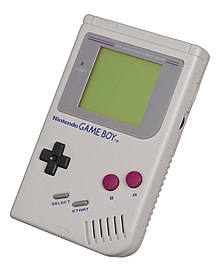 The original gray Game Boy | |
| Also known as | DMG-01
|
|---|---|
| Developer | Nintendo R&D1 |
| Manufacturer | Nintendo |
| Product family | Game Boy |
| Type | Handheld game console |
| Generation | Fourth |
| Release date | |
| Introductory price | |
| Discontinued |
|
| Units sold | 118.69 million (including all variants and Game Boy Color)[11] |
| Media | Game Boy Game Pak |
| System on a chip |
|
| CPU | Sharp SM83 @ 4 MHz |
| Memory | 8 KB RAM, 8 KB VRAM |
| Display | |
| Best-selling game | Pokémon Red, Blue, and Yellow (46 million units) |
| Predecessor | Game & Watch |
| Successor | Game Boy Color |
The Game Boy is a handheld game console developed by Nintendo, launched in the Japanese home market on April 21, 1989, followed by North America later that year and other territories from 1990 onwards. Following the success of the Game & Watch single-game handhelds, Nintendo developed the Game Boy to be more like a portable console, with interchangeable cartridges. The concept proved highly successful and the Game Boy became a cultural icon of the 1990s and early 2000s.
The Game Boy was designed by the Nintendo Research & Development 1 team, led by Gunpei Yokoi and Satoru Okada. The device features a dot-matrix display, a directional pad, four game buttons, a single speaker, and uses Game Pak cartridges. The two-toned gray design with black, blue, and dark magenta accents sported softly rounded corners, except for the bottom right, which was curved. At launch, it was sold either as a standalone unit or bundled with games like Super Mario Land and Tetris.
Despite mixed reviews criticizing its monochrome graphics and larger size compared to competitors like the Sega Game Gear, Atari Lynx, and NEC TurboExpress, the Game Boy rapidly outsold them all. An estimated 118.69 million units of the Game Boy and its successor, the Game Boy Color (1998), have been sold worldwide, making it the fourth-best-selling console ever. The Game Boy received several redesigns during its lifespan, including the smaller Game Boy Pocket (1996) and the Game Boy Light (1998). Sales of Game Boy variants continued until 2003.
- ^ White, Dave (July 1989). "Gameboy Club". Nintendo Power. No. 7. p. 84.
- ^ "retrodiary: 1 April – 28 April". Retro Gamer. No. 88. Bournemouth: Imagine Publishing. April 2011. p. 17. ISSN 1742-3155. OCLC 489477015.
- ^ "Video Games Around the World: South Africa". Archived from the original on September 25, 2022.
- ^ "Соглашение Steepler и Nintendo". November 1994.
- ^ "Playtronic lança em abril Game Boy da Nintendo". folha.uol.com.br (in Portuguese). March 30, 1994. Retrieved September 28, 2024.
- ^ "Bajtek 1994 11". November 1994.
- ^ Edwards, Benj (April 21, 2019). "Happy 30th B-Day, Game Boy: Here are six reasons why you're #1". Ars Technica. Archived from the original on May 4, 2024. Retrieved May 26, 2024.
- ^ Moriarty, Colin (October 15, 2013). "The Real Cost of Gaming: Inflation, Time, and Purchasing Power". IGN. Archived from the original on September 15, 2020. Retrieved August 28, 2020.
- ^ "Console Crazy!". ACE. No. 37. September 1990. p. 142. Archived from the original on April 1, 2024. Retrieved April 1, 2024.
- ^ Freundorfer, Stephan (October 12, 2015). "Matsch-Screen statt Touchscreen". Der Spiegel. Archived from the original on November 8, 2020. Retrieved August 28, 2020.
- ^ "Consolidated Sales Transition by Region" (PDF). Nintendo. April 26, 2016. Archived from the original (PDF) on April 27, 2016. Retrieved October 23, 2016.